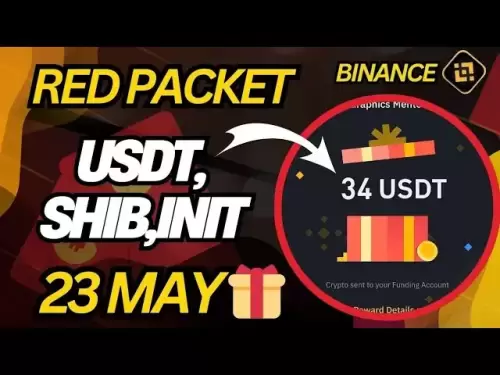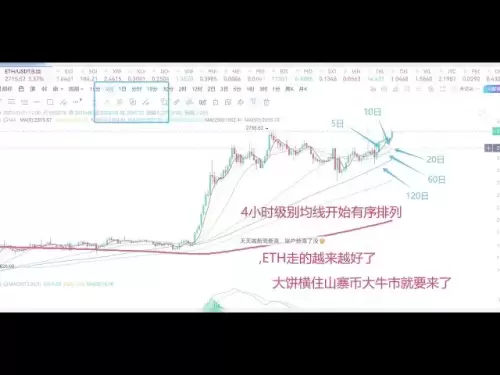-
 Bitcoin
Bitcoin $109,059.9886
-2.03% -
 Ethereum
Ethereum $2,571.4473
-3.50% -
 Tether USDt
Tether USDt $1.0001
0.00% -
 XRP
XRP $2.3626
-2.88% -
 BNB
BNB $670.8414
-1.63% -
 Solana
Solana $180.9172
1.01% -
 USDC
USDC $0.9997
0.00% -
 Dogecoin
Dogecoin $0.2347
-2.78% -
 Cardano
Cardano $0.7789
-3.05% -
 TRON
TRON $0.2676
-3.62% -
 Sui
Sui $3.6653
-6.71% -
 Hyperliquid
Hyperliquid $35.0692
8.85% -
 Chainlink
Chainlink $16.2211
-3.50% -
 Avalanche
Avalanche $24.5163
-2.15% -
 Stellar
Stellar $0.2924
-3.01% -
 Bitcoin Cash
Bitcoin Cash $443.3685
1.95% -
 Shiba Inu
Shiba Inu $0.0...01479
-3.54% -
 Hedera
Hedera $0.1988
-2.61% -
 UNUS SED LEO
UNUS SED LEO $8.7551
-1.23% -
 Toncoin
Toncoin $3.0551
-3.65% -
 Litecoin
Litecoin $98.4828
-0.74% -
 Polkadot
Polkadot $4.7213
-4.31% -
 Monero
Monero $395.8168
-1.12% -
 Bitget Token
Bitget Token $5.5662
6.84% -
 Pepe
Pepe $0.0...01480
2.53% -
 Pi
Pi $0.7614
-6.37% -
 Dai
Dai $0.9997
-0.02% -
 Ethena USDe
Ethena USDe $1.0002
-0.02% -
 Bittensor
Bittensor $448.8677
-5.39% -
 Uniswap
Uniswap $6.1428
-5.02%
How to use KDJ in a large-volume decline? Is it a bottom-fishing signal or a stop-loss signal?
During large-volume declines, use KDJ to spot bottom-fishing opportunities when lines drop below 20 and show a bullish crossover, but set stop-losses if bearish signals persist.
May 23, 2025 at 10:42 am
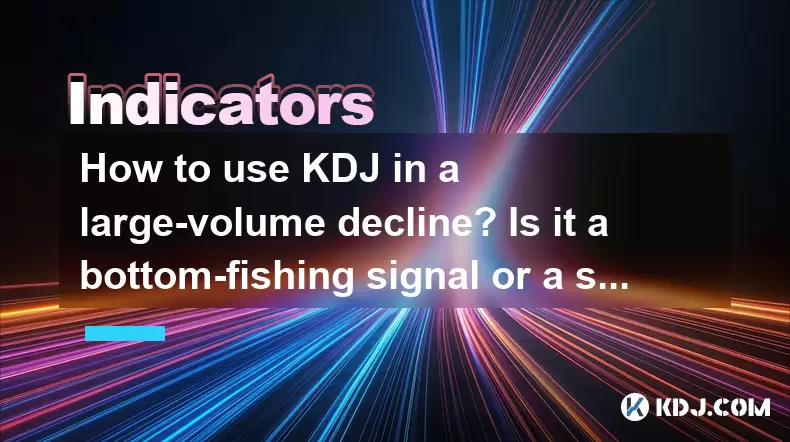
How to Use KDJ in a Large-Volume Decline? Is It a Bottom-Fishing Signal or a Stop-Loss Signal?
The KDJ indicator is a popular technical analysis tool used by traders in the cryptocurrency market to identify potential buy and sell signals. It is particularly useful during periods of significant volume declines, as it can help traders determine whether a price drop is a buying opportunity or a sign to exit their positions. In this article, we will explore how to use the KDJ indicator effectively during large-volume declines and discuss whether it should be interpreted as a bottom-fishing signal or a stop-loss signal.
Understanding the KDJ Indicator
The KDJ indicator is a momentum oscillator that combines elements of the stochastic oscillator with a moving average. It consists of three lines: the K line, the D line, and the J line. The K and D lines are derived from the stochastic oscillator, while the J line is a more sensitive measure that is calculated using the K and D lines.
- K Line: The K line is the fastest line and represents the current market momentum.
- D Line: The D line is a moving average of the K line and is used to smooth out the K line's fluctuations.
- J Line: The J line is calculated as
J = 3D - 2Kand is used to identify overbought and oversold conditions more quickly than the K and D lines alone.
Identifying Large-Volume Declines
A large-volume decline in the cryptocurrency market is characterized by a significant drop in price accompanied by a substantial increase in trading volume. This often indicates a shift in market sentiment and can be a critical point for traders to assess their positions.
To identify a large-volume decline, traders should:
- Monitor the trading volume on their chosen cryptocurrency exchange.
- Look for a sudden spike in volume that coincides with a sharp price drop.
- Use technical analysis tools, such as volume indicators, to confirm the increase in trading activity.
Using KDJ During Large-Volume Declines
When a large-volume decline occurs, the KDJ indicator can provide valuable insights into the market's direction. Traders should pay close attention to the following aspects of the KDJ indicator:
- Overbought and Oversold Levels: The KDJ indicator typically uses levels of 80 and 20 to identify overbought and oversold conditions, respectively. During a large-volume decline, if the KDJ lines fall below 20, it may indicate that the market is oversold.
- Crossing of K and D Lines: A bullish crossover occurs when the K line crosses above the D line, suggesting a potential reversal in the downtrend. Conversely, a bearish crossover occurs when the K line crosses below the D line, indicating a continuation of the downtrend.
- J Line Movement: The J line can provide early signals of a potential reversal. If the J line moves from below 20 to above 20, it may signal that the market is recovering from an oversold condition.
Is KDJ a Bottom-Fishing Signal During Large-Volume Declines?
Bottom-fishing refers to the strategy of buying assets that have experienced a significant price drop in the hope of a rebound. During a large-volume decline, the KDJ indicator can be used to identify potential bottom-fishing opportunities.
To use the KDJ indicator as a bottom-fishing signal during a large-volume decline, follow these steps:
- Monitor the KDJ lines for a drop below the 20 level, indicating an oversold condition.
- Look for a bullish crossover of the K line above the D line, suggesting a potential reversal.
- Confirm the signal with the J line moving from below 20 to above 20, indicating a recovery from an oversold state.
- Consider entering a long position when these conditions are met, but always use proper risk management techniques, such as setting stop-loss orders.
Is KDJ a Stop-Loss Signal During Large-Volume Declines?
A stop-loss signal is a trigger for exiting a position to limit potential losses. During a large-volume decline, the KDJ indicator can also be used to determine when to exit a position.
To use the KDJ indicator as a stop-loss signal during a large-volume decline, follow these steps:
- Monitor the KDJ lines for a drop below the 20 level, indicating an oversold condition.
- Look for a bearish crossover of the K line below the D line, suggesting a continuation of the downtrend.
- Confirm the signal with the J line remaining below 20, indicating persistent oversold conditions.
- Consider exiting a long position when these conditions are met, especially if the price continues to decline and the volume remains high.
Practical Example of Using KDJ During a Large-Volume Decline
Let's consider a practical example of how to use the KDJ indicator during a large-volume decline in the cryptocurrency market.
- Scenario: A trader is monitoring Bitcoin (BTC) on a popular exchange and notices a significant price drop accompanied by a spike in trading volume.
- Step 1: The trader observes that the KDJ lines have dropped below the 20 level, indicating an oversold condition.
- Step 2: The trader watches for a bullish crossover of the K line above the D line, which occurs after the initial drop.
- Step 3: The trader confirms the signal by observing the J line moving from below 20 to above 20, suggesting a potential recovery.
- Step 4: The trader decides to enter a long position on BTC, setting a stop-loss order to manage risk.
In this scenario, the KDJ indicator provided a bottom-fishing signal during a large-volume decline, allowing the trader to potentially capitalize on a price rebound.
Frequently Asked Questions
Q1: Can the KDJ indicator be used in conjunction with other technical indicators during large-volume declines?
A1: Yes, the KDJ indicator can be used in combination with other technical indicators, such as the Relative Strength Index (RSI) or Moving Averages, to confirm signals and enhance trading decisions during large-volume declines.
Q2: How often should I check the KDJ indicator during a large-volume decline?
A2: It is recommended to check the KDJ indicator regularly, such as every few hours or at key trading sessions, to stay updated on market conditions and potential signals during a large-volume decline.
Q3: Are there any specific timeframes that work best with the KDJ indicator during large-volume declines?
A3: The effectiveness of the KDJ indicator can vary depending on the timeframe used. Shorter timeframes, such as 15-minute or 1-hour charts, may provide more timely signals during large-volume declines, while longer timeframes, such as 4-hour or daily charts, can offer more reliable signals for longer-term trends.
Q4: How can I adjust the KDJ settings to better suit large-volume declines?
A4: Adjusting the KDJ settings, such as the period length for the K and D lines, can help tailor the indicator to specific market conditions. During large-volume declines, traders may consider using shorter periods to capture more rapid changes in market momentum. Experimenting with different settings and backtesting can help find the optimal configuration for individual trading strategies.
Disclaimer:info@kdj.com
The information provided is not trading advice. kdj.com does not assume any responsibility for any investments made based on the information provided in this article. Cryptocurrencies are highly volatile and it is highly recommended that you invest with caution after thorough research!
If you believe that the content used on this website infringes your copyright, please contact us immediately (info@kdj.com) and we will delete it promptly.
- Launch of CME Group's XRP Futures Has Sent Bullish Waves Through the Market
- 2025-05-24 00:10:14
- Trump hosted a swanky dinner last night for the top investors of his $TRUMP meme coin project
- 2025-05-24 00:10:14
- Colle AI platform expands its capabilities related to Bitcoin to revolutionize the scalable distribution of NFTs
- 2025-05-24 00:05:13
- More Than 200 Wealthy Crypto Bros Gathered for a Private Dinner with Trump at His Golf Club
- 2025-05-24 00:05:13
- SUI Hack Results in $220M Exploit, $6M Bounty Offered to Recover Funds
- 2025-05-24 00:00:55
- Cardano (ADA) Open Interest Rises 25% as Buyers Return to the Crypto Market
- 2025-05-24 00:00:55
Related knowledge
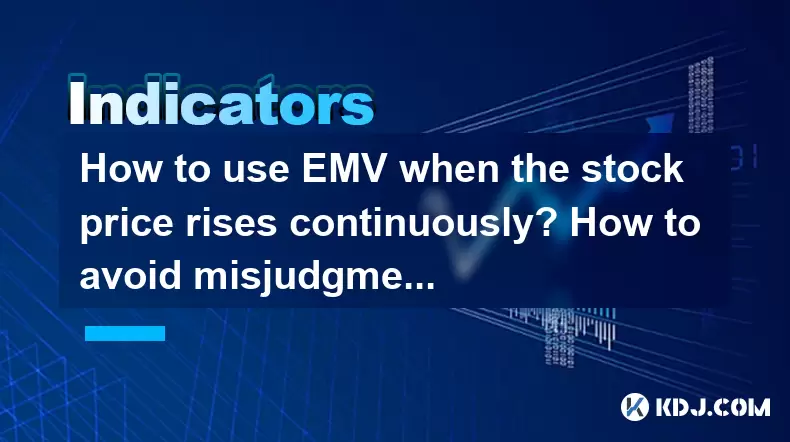
How to use EMV when the stock price rises continuously? How to avoid misjudgment in extreme market conditions?
May 23,2025 at 07:29pm
In the dynamic world of cryptocurrency trading, the Exponential Moving Average (EMA) is a powerful tool that traders use to make informed decisions, especially during periods of continuous stock price rises. Understanding how to effectively use EMAs and avoiding misjudgment in extreme market conditions are crucial skills for any crypto trader. This arti...
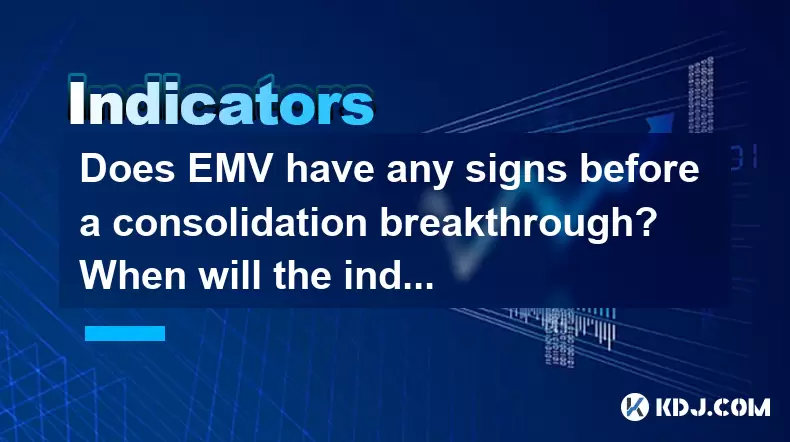
Does EMV have any signs before a consolidation breakthrough? When will the indicator give an early warning?
May 23,2025 at 06:42pm
Does EMV have any signs before a consolidation breakthrough? When will the indicator give an early warning? The Ease of Movement Value (EMV) is a technical indicator that helps traders understand the relationship between price and volume in the cryptocurrency market. It is particularly useful for identifying potential breakouts from consolidation period...
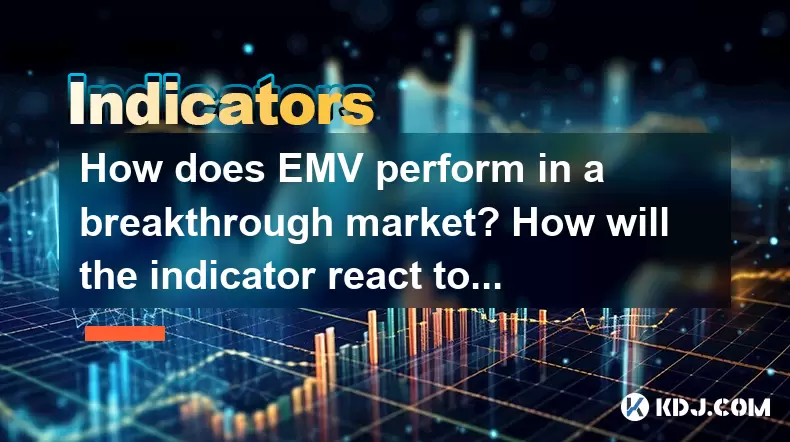
How does EMV perform in a breakthrough market? How will the indicator react to a false breakthrough?
May 23,2025 at 06:01pm
Introduction to EMV IndicatorThe Ease of Movement Value (EMV) indicator is a technical analysis tool that helps traders identify the relationship between price and volume in the cryptocurrency market. Developed by Richard W. Arms, Jr., the EMV indicator aims to measure the 'ease' with which prices move. In a breakthrough market, understanding how EMV pe...
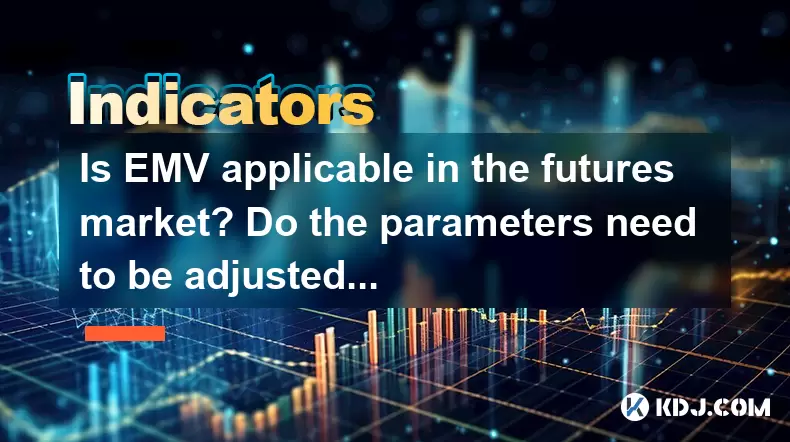
Is EMV applicable in the futures market? Do the parameters need to be adjusted in a leveraged environment?
May 23,2025 at 05:15pm
The application of Exponential Moving Average (EMV) in the futures market, particularly within a leveraged environment, is a topic that garners significant interest among traders. EMV, a type of moving average that places greater weight on recent price data, can be a useful tool for traders in the futures market. However, its effectiveness and the neces...
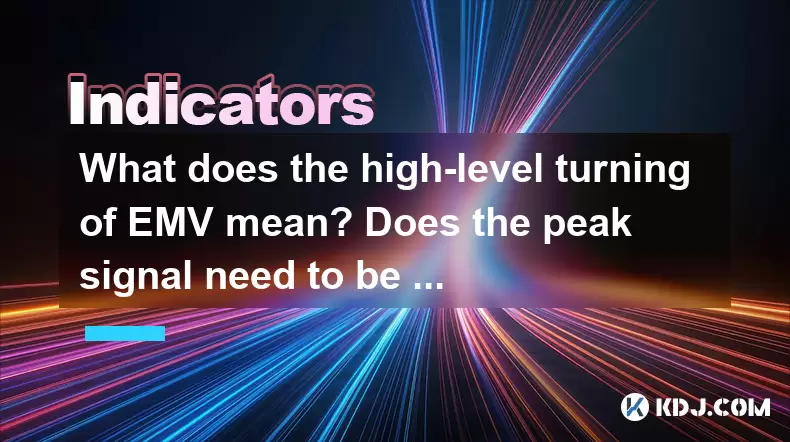
What does the high-level turning of EMV mean? Does the peak signal need to be confirmed by other indicators?
May 23,2025 at 09:56pm
Understanding the High-Level Turning of EMVThe Easing of Market Volatility (EMV) is a crucial metric in the cryptocurrency market, used to gauge the sentiment and potential shifts in market trends. When we talk about the high-level turning of EMV, we refer to a significant change in this metric, indicating a shift from high volatility to lower volatilit...
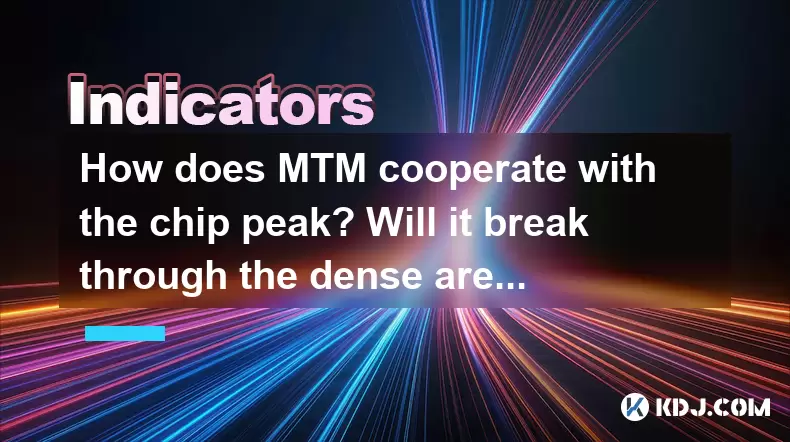
How does MTM cooperate with the chip peak? Will it break through the dense area?
May 23,2025 at 11:07pm
Introduction to MTM and Chip PeakMTM, or Market Timing Model, is a popular tool among cryptocurrency traders to predict market trends and optimize their trading strategies. On the other hand, the chip peak refers to the highest concentration of cryptocurrency holdings by investors, often signaling potential resistance levels in the market. Understanding...

How to use EMV when the stock price rises continuously? How to avoid misjudgment in extreme market conditions?
May 23,2025 at 07:29pm
In the dynamic world of cryptocurrency trading, the Exponential Moving Average (EMA) is a powerful tool that traders use to make informed decisions, especially during periods of continuous stock price rises. Understanding how to effectively use EMAs and avoiding misjudgment in extreme market conditions are crucial skills for any crypto trader. This arti...

Does EMV have any signs before a consolidation breakthrough? When will the indicator give an early warning?
May 23,2025 at 06:42pm
Does EMV have any signs before a consolidation breakthrough? When will the indicator give an early warning? The Ease of Movement Value (EMV) is a technical indicator that helps traders understand the relationship between price and volume in the cryptocurrency market. It is particularly useful for identifying potential breakouts from consolidation period...

How does EMV perform in a breakthrough market? How will the indicator react to a false breakthrough?
May 23,2025 at 06:01pm
Introduction to EMV IndicatorThe Ease of Movement Value (EMV) indicator is a technical analysis tool that helps traders identify the relationship between price and volume in the cryptocurrency market. Developed by Richard W. Arms, Jr., the EMV indicator aims to measure the 'ease' with which prices move. In a breakthrough market, understanding how EMV pe...

Is EMV applicable in the futures market? Do the parameters need to be adjusted in a leveraged environment?
May 23,2025 at 05:15pm
The application of Exponential Moving Average (EMV) in the futures market, particularly within a leveraged environment, is a topic that garners significant interest among traders. EMV, a type of moving average that places greater weight on recent price data, can be a useful tool for traders in the futures market. However, its effectiveness and the neces...

What does the high-level turning of EMV mean? Does the peak signal need to be confirmed by other indicators?
May 23,2025 at 09:56pm
Understanding the High-Level Turning of EMVThe Easing of Market Volatility (EMV) is a crucial metric in the cryptocurrency market, used to gauge the sentiment and potential shifts in market trends. When we talk about the high-level turning of EMV, we refer to a significant change in this metric, indicating a shift from high volatility to lower volatilit...

How does MTM cooperate with the chip peak? Will it break through the dense area?
May 23,2025 at 11:07pm
Introduction to MTM and Chip PeakMTM, or Market Timing Model, is a popular tool among cryptocurrency traders to predict market trends and optimize their trading strategies. On the other hand, the chip peak refers to the highest concentration of cryptocurrency holdings by investors, often signaling potential resistance levels in the market. Understanding...
See all articles




















